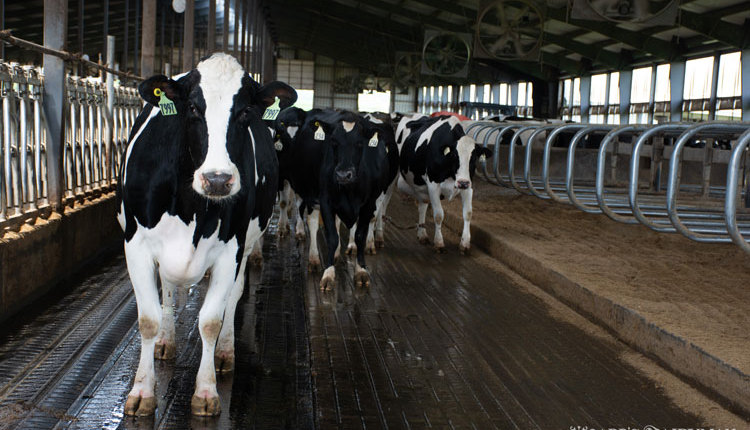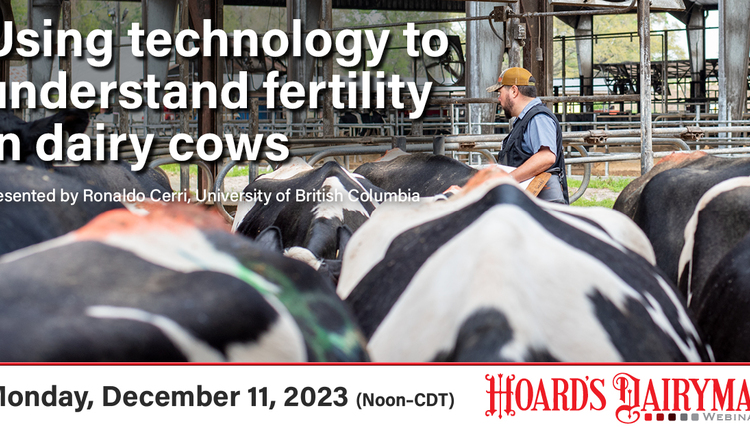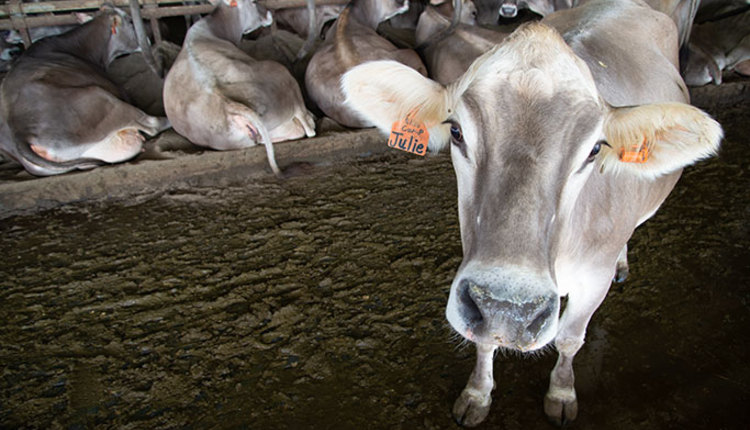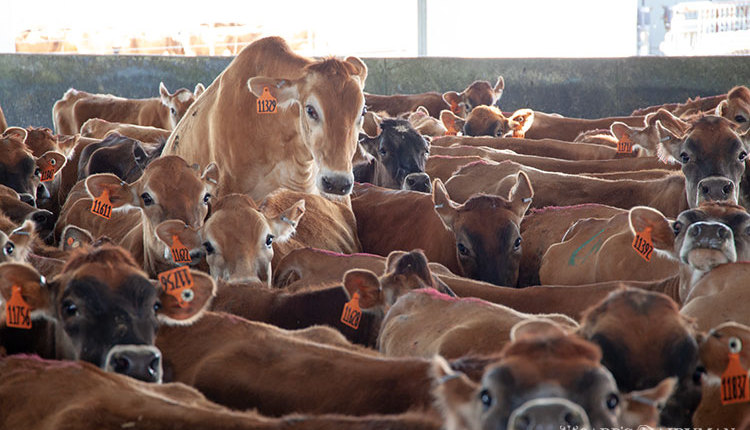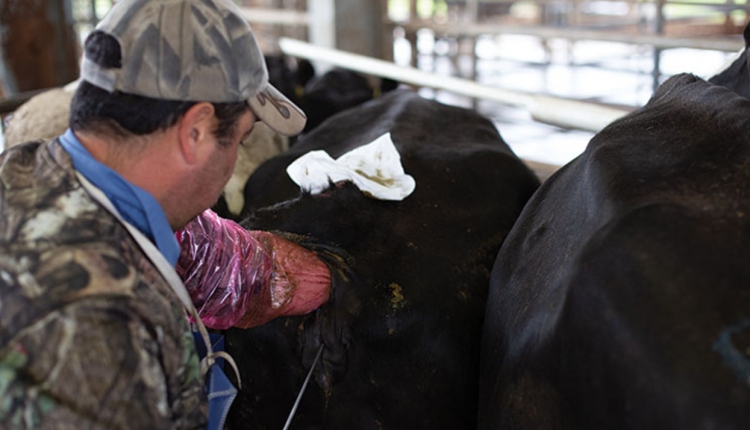Use of gender- or sex-sorted A.I. semen continues to grow rapidly among U.S. dairy producers, even though the technology is still in its relative infancy.
The first limited commercial distributions of sex-sorted semen began just four years ago, and from the outset A.I. studs have aggressively gathered data about both its usage and performance.
While average first-service conception rate (45 percent) and heifer calf ratio results (90 percent) have become widely known by producers, far less information has been published about patterns involving stillbirths and twinning, said Dr. Mel DeJarnette of Select Sires at the 2008 Dairy Cattle Reproduction Council Convention in Omaha, Nebraska, in November.
Using records compiled from three years of sex-sorted semen use by the firm's customers, and data from a large-scale regional DHIA organization, DeJarnette presented several interesting comparisons for stillbirth and twinning incidence between heifers bred with sex-sorted and conventional semen.
DeJarnette emphasized that the total incidence of stillbirths is not influenced by the use of sex-sorted semen. Although not statistically significant, he pointed out that the incidence of stillborns is actually slightly less for sex-sorted semen (10.4 percent) than for conventional semen (11.8 percent) and for previously reported national averages for Holstein heifers.
On the other hand, the incidence of stillborn births for male calves from sex-sorted semen (19.9 percent) is much higher than for conventional semen (12.9 percent). This difference is especially pronounced when heifers calve at 23, 24, or 25 months of age, versus those that calve earlier or later.
Since bull calves represent only about 10 percent of sex-selected semen births, DeJarnette noted that in any group of 100 births resulting from sex-sorted semen one would expect to see just two stillborn bull calves.
Stillbirth incidence for female calves resulting from sex-sorted semen (9.2 percent) is identical or slightly lower than conventional semen stillbirths (10.5 percent) at every calving age, and is somewhat significantly lower at ages of 26 months or more.
Some of the most interesting findings DeJarnette presented involved twinning differences between sex-sorted and conventional semen. He noted, however, that the incidence of twins is similar for both and is consistent with data reported by DHIA organizations.
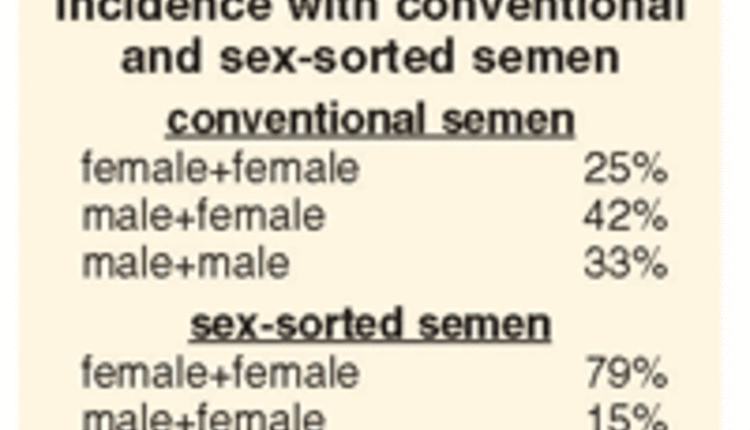 That said, he also pointed out that when twinning does occur, dairy producers are much more likely to get heifer calves with sex-sorted semen than they are with conventional semen. His breakdown of sex pairings in twin-born calf incidence is presented in the accompanying table.
That said, he also pointed out that when twinning does occur, dairy producers are much more likely to get heifer calves with sex-sorted semen than they are with conventional semen. His breakdown of sex pairings in twin-born calf incidence is presented in the accompanying table.
"Considering the incidence of free-martins, only 25 percent of twin-born offspring from conventional semen have the possibility to become productive members of the herd, compared to 79 percent for sex-sorted semen," he said.
"In in some herds where twinning rates can exceed 10 percent, the distribution of calf sex could be economically relevant should the use of sex-sorted semen in lactating cows ever become a viable recommendation."
Click here to return to the Reproduction E-Sources
090225_W35
The first limited commercial distributions of sex-sorted semen began just four years ago, and from the outset A.I. studs have aggressively gathered data about both its usage and performance.
While average first-service conception rate (45 percent) and heifer calf ratio results (90 percent) have become widely known by producers, far less information has been published about patterns involving stillbirths and twinning, said Dr. Mel DeJarnette of Select Sires at the 2008 Dairy Cattle Reproduction Council Convention in Omaha, Nebraska, in November.
Using records compiled from three years of sex-sorted semen use by the firm's customers, and data from a large-scale regional DHIA organization, DeJarnette presented several interesting comparisons for stillbirth and twinning incidence between heifers bred with sex-sorted and conventional semen.
Stillbirths
DeJarnette emphasized that the total incidence of stillbirths is not influenced by the use of sex-sorted semen. Although not statistically significant, he pointed out that the incidence of stillborns is actually slightly less for sex-sorted semen (10.4 percent) than for conventional semen (11.8 percent) and for previously reported national averages for Holstein heifers.
On the other hand, the incidence of stillborn births for male calves from sex-sorted semen (19.9 percent) is much higher than for conventional semen (12.9 percent). This difference is especially pronounced when heifers calve at 23, 24, or 25 months of age, versus those that calve earlier or later.
Since bull calves represent only about 10 percent of sex-selected semen births, DeJarnette noted that in any group of 100 births resulting from sex-sorted semen one would expect to see just two stillborn bull calves.
Stillbirth incidence for female calves resulting from sex-sorted semen (9.2 percent) is identical or slightly lower than conventional semen stillbirths (10.5 percent) at every calving age, and is somewhat significantly lower at ages of 26 months or more.
Twinning
Some of the most interesting findings DeJarnette presented involved twinning differences between sex-sorted and conventional semen. He noted, however, that the incidence of twins is similar for both and is consistent with data reported by DHIA organizations.
 That said, he also pointed out that when twinning does occur, dairy producers are much more likely to get heifer calves with sex-sorted semen than they are with conventional semen. His breakdown of sex pairings in twin-born calf incidence is presented in the accompanying table.
That said, he also pointed out that when twinning does occur, dairy producers are much more likely to get heifer calves with sex-sorted semen than they are with conventional semen. His breakdown of sex pairings in twin-born calf incidence is presented in the accompanying table."Considering the incidence of free-martins, only 25 percent of twin-born offspring from conventional semen have the possibility to become productive members of the herd, compared to 79 percent for sex-sorted semen," he said.
"In in some herds where twinning rates can exceed 10 percent, the distribution of calf sex could be economically relevant should the use of sex-sorted semen in lactating cows ever become a viable recommendation."
090225_W35
